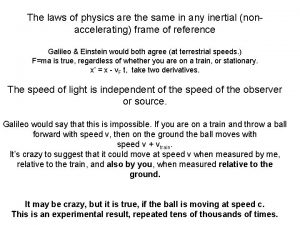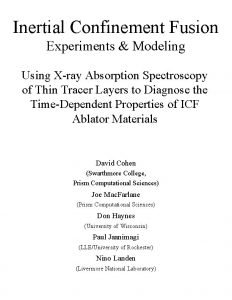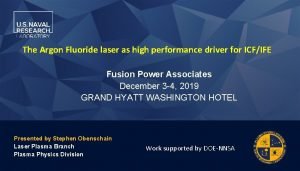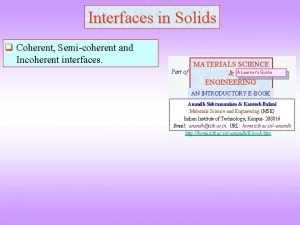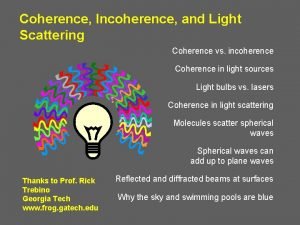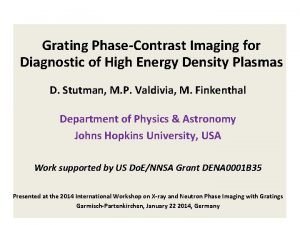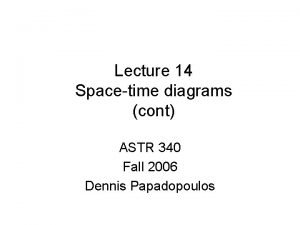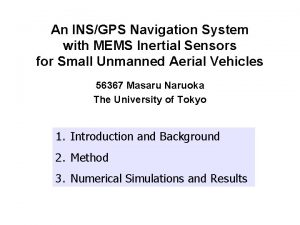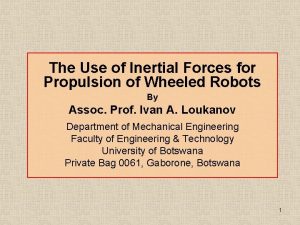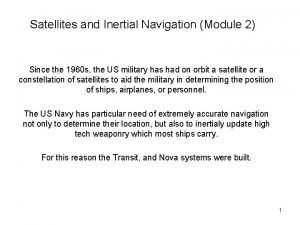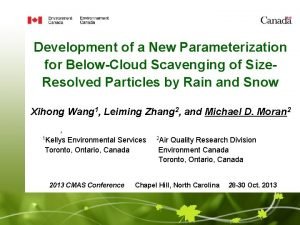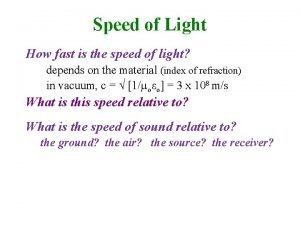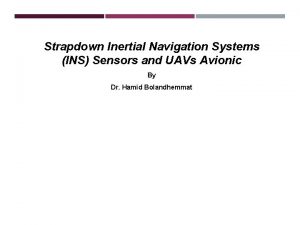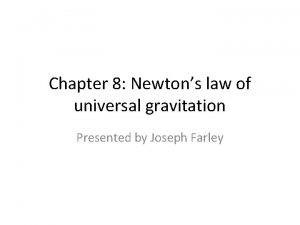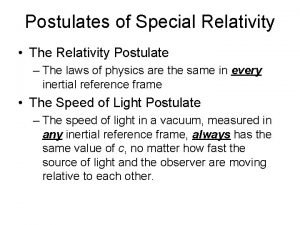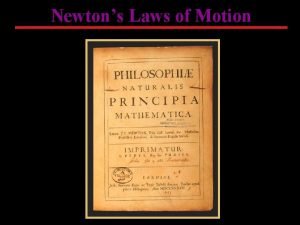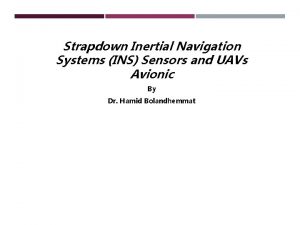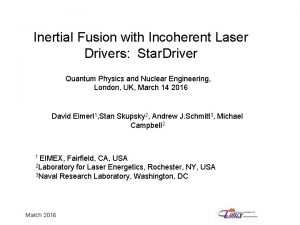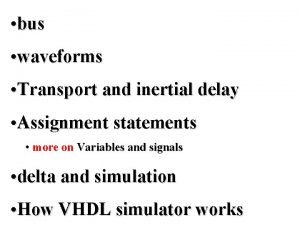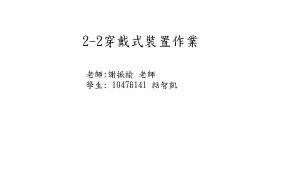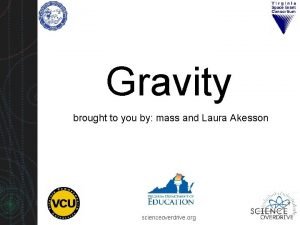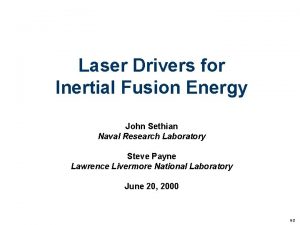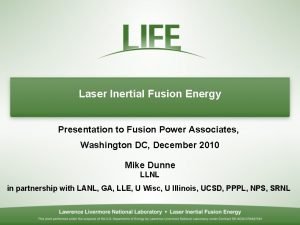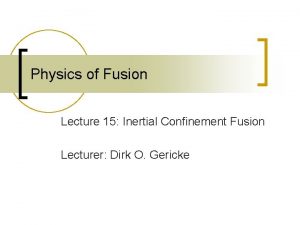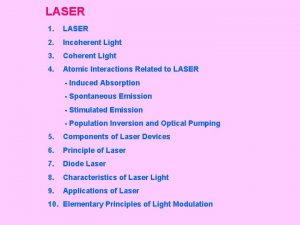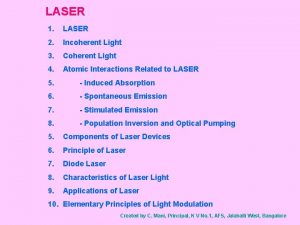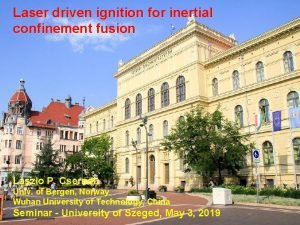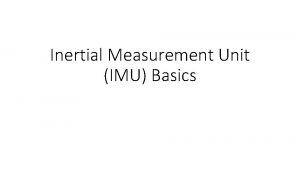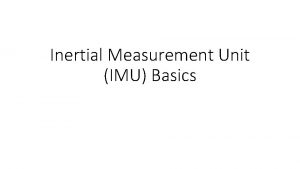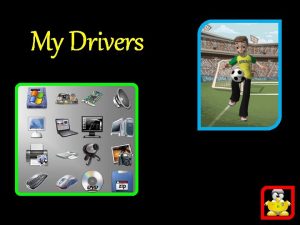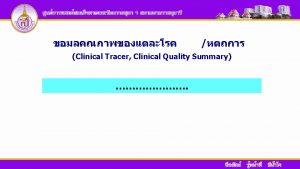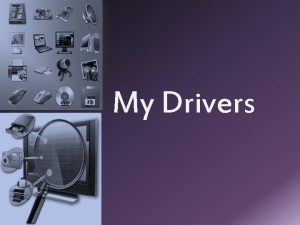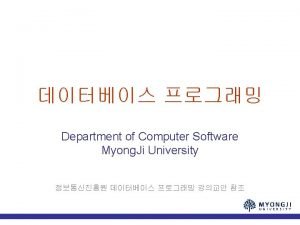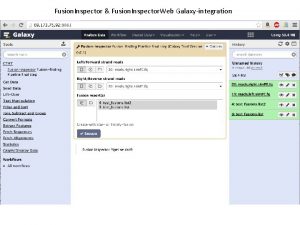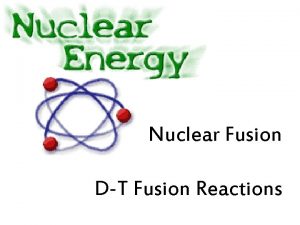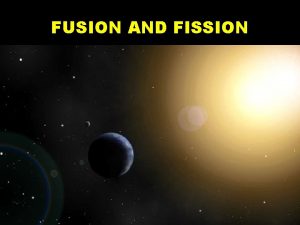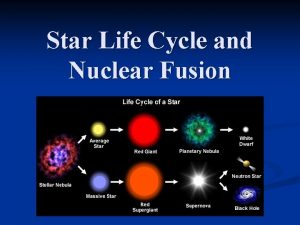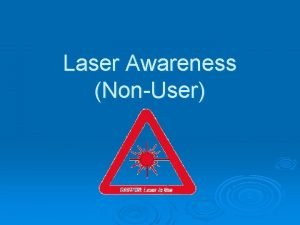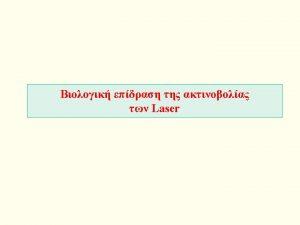Inertial Fusion with Incoherent Laser Drivers Star Driver

































- Slides: 33

Inertial Fusion with Incoherent Laser Drivers: Star. Driver Quantum Physics and Nuclear Engineering, London, UK, March 14 2016 David Eimerl 1, Stan Skupsky 2, Andrew J. Schmitt 3, Michael Campbell 2 1 EIMEX, Fairfield, CA, USA 2 Laboratory for Laser Energetics, Rochester, NY, USA 3 Naval Research Laboratory, Washington, DC March 2016

Talk Outline Current problems in inertial confinement fusion Incoherence as their solution : Star. Driver Spatial coherence and hydrodynamics Bandwidth and laser-plasma instabilities Laser Technology March 2016

Inertial confinement fusion uses a large laser (about 1 Mega. Joule) to compress a small pellet of DT to burn. Laser Ablation For ignition: R/r~ 25 For energy gain of 50: R/r ~ 40 R 2 r Hot dense fuel Fuel sphericity at burn is determined by the L-mode content of the drive March 2016 Fusion energy production has significantly tighter tolerances than ignition.

There are two legacy approaches to inertial confinement fusion: direct drive and indirect drive. Indirect Drive Direct Drive UV/visible light RT corona 2 wpe/CBET Wall motion Time-dependent asymmetry 2 wpe, CBET SRS/SBS RT Hohlraum Thermal X-rays? Control and perhaps elimination of instabilities may possibly be achieved using UV/visible radiation with (enough of) the highly incoherent features of thermal X-rays. March 2016

Incoherent drive is motivated by considerations of both target physics and laser science and engineering Laser experiments in both indirect drive and direct drive ICF have exposed several types of instabilities that present significant challenges to achieving ignition. (A) Hydrodynamic Imprint, target manufacturing and ablation drive symmetry (B) Laser-Plasma Spatial interference pattern, spatial coherence (phase matching), laser coherence time (C) Laser Technology Cost, reliability March 2016

Comparison of Thermal Radiation with Laser Radiation Thermal/X-ray: Legacy Laser Systems: Glass Lasers: Mean Wavelength ~ 1 nm Bandwidth ~ 106 THz Wavelength ~ 350 nm Laser optical frequency ~ 103 THz Bandwidth ~ 0. 001 - 1 THz Kr. F Laser : Wavelength Bandwidth Spatial coherence length Coherence time March 2016 ~ 248 nm ~ 5 THz ~ 2 nm ~ 10 -18 s length Coherence time ~ 1000 nm ~ 10 -9 - 10 -13 s

Talk Outline Current problems in inertial confinement fusion Incoherence as a key element: Star. Driver Spatial coherence and hydrodynamics Bandwidth and laser-plasma instabilities Laser Technology March 2016

Broad or ultra-broad bandwidth is key to controlling instabilities Imprint and ablative drive pressure non-uniformities are significantly reduced by increasing the bandwidth of the laser drive. Asymptotic smoothing levels <1% can be reached in a few hundred ps rather than nanoseconds, with 2% laser bandwidth at 351 nm. One method to reduce or suppress the most significant laser-plasma instabilities is high laser bandwidth (2%-10%) and/or a high density of modes in k-space. Star. Driver offers both control of instabilities and extreme system flexibility by configuring the laser drive as many nearly monochromatic beamlets spanning a wide range in frequency. March 2016

The Star. Driver-class laser fusion concept Target In total, there about 10, 000 beamlets, sized at the sweet spot of the laser-optical technology, each one ~100 Joules, 5 -10 cm in aperture, delivering ~1 MJ on target Each beamlet is nearly monochromatic Effectively ~4 p illumination Grouped to allow collection of released energy Each beamlet has a different wavelength from the others The effective bandwidth of the laser drive is the bandwidth spanned by overlapping beamlets at the target. Different focusing/timing strategies will enable time-dependent features in the drive such as zooming. March 2016

Talk Outline Current problems in inertial confinement fusion Incoherence as their solution : Star. Driver Spatial coherence and hydrodynamics Bandwidth and laser-plasma instabilities Laser Technology March 2016

The many beamlets create together a 3 D speckle pattern on the small pellet. The speckle pattern, if static, causes the pellet to distort as it is compressed, because a static speckle pattern creates a persistent nonspherical pressure. With bandwidth, the speckle pattern “shimmers” thereby smoothing out the pressure on the pellet and enabling a truly spherical implosion. The rms pressure variation is required to be < 1% March 2016

A hard sphere target model applies at very early times and avoids the complexities of propagation and absorption in the corona Target radius Lab Z-axis Laser Spot 1/e point (x, y) Beamlet Axis R-z e X s Zoom = ratio of laser spot 1/e point to target (hard sphere) radius March 2016 o (out of plane) P Tangent Plane at P Z

The asymptotic RMS beam smoothness (d. I/I) is not low enough with monochromatic beams >150, 00 beamlets (without SSD) are needed to reach 1% asymptotic smoothness March 2016

2 D SSD disperses each beamlet and adds many speckle patterns to the drive on target Monochromatic beam Gratings and modulators ~300 GHz dispersed beam with many speckle patterns Frequencies (GHz, at 3 w) 74. 1 173. 4 Phase Amplitudes 6. 34 4. 02 Fraction of target radius/mode) 0. 01 2 D SSD allows 5120 physical beamlets in a ported configuration to provide over 400, 000 speckle patterns at the target. The initial rate of decrease of the RMS smoothness is given by the total drive bandwidth, but asymptotically the RMS smoothness approaches the limit controlled by the 2 D SSD. March 2016

2 D SSD enables asymptotic smoothness below 1% for 5120 beamlets with 2% and 10% bandwidth at 351 nm d. I/I RMS Smoothness 2% Bandwidth without SSD 0. 100 2% Bandwidth with 2 D SSD 10% Bandwidth with 2 D SSD 0. 010 5120 Beamlets 0. 001 March 2016 0. 01 0. 1 1 10 100 Smoothing Time (ps) 10000

2 D SSD improves the asymptotic low L-mode symmetry for zoom < 0. 75 Low L-mode Spectrum 0 -1 -2 -3 72000 beamlets No SSD 5120 beamlets No SSD Log(Pl) -4 -5 -6 -7 5120 beamlets with SSD -8 -9 0 5 10 15 L Mode March 2016 20 25

Talk Outline Current problems in inertial confinement fusion Incoherence as their solution : Star. Driver Spatial coherence and hydrodynamics Bandwidth and laser-plasma instabilities Laser Technology March 2016

Corona Profiles in IFE-scale direct drive targets Density n/nc 1. 2 Temperature T/mc 2 0. 014 1 0. 012 0. 8 0. 01 0. 008 0. 6 0. 006 0. 4 0. 004 0. 2 0. 002 0 0 0. 05 0. 15 0. 25 0 0. 3 0 Radius (cm) 0. 1 0. 2 Radius (cm) Profile # 1 2 3 4 5 Time Critical radius 9. 5 1. 044 10. 12 1. 02 11 0. 975 12 0. 806 13 0. 586 ns mm Total laser power 57 186 248 247 245. 8 TW Density/Critical density at maximum growth rate 0. 2456 0. 2424 0. 2395 0. 2382 0. 2359 Radius 1. 229 1. 289 1. 383 1. 255 1. 054 mm Gradient scale length 256 318 481 473 477 microns Temperature 1. 919 3. 352 4. 604 5. 132 6. 16 ke. V Threshold Parameter 103 259 369 396 469 March 2016 0. 3

The spectrum of all the rays that penetrate to a depth in the corona forms a “k-space” of laser modes About 4000 rays from 5120 beamlets penetrate to the ¼ critical surface and overlap there. The k-space is an approximation to a fully incoherent thermal distribution of light energy Length proportional to ray intensity March 2016 Length proportional to ray frequency offset at (2% bandwidth)

The 2 wpe instability driven by an incoherent driver “k-space” Conjugate kspace (w. L<0) Electron wave Conjugate electron wave spectrum (w<0) + + Conjugate electron wave spectrum (w<0) March 2016 k-space (w. L>0) positive feedback for original electron wave

A system bandwidth of ~3% bandwidth suppresses the 2 wpe instability in IFE-scale targets March 2016

The ultra-broad bandwidth of Star. Driver enables the suppression of laser-plasma instabilities Laser bandwidth required for LPI control: 2 wpe: ~2– 3% SRS: ~1– 3% SBS: ≤ 0. 1% Star. Driver. TM vs Large Aperture Laser Systems: LIFE bandwidth 0. 02% Kr. F bandwidth 0. 25% Star. Driver. TM bandwidth 1%-10% The bandwidth of Star. Driver can be as large as that of the range of available (and suitable) laser gain media. Bandwidth adequate to suppress LPI completely (i. e. ultrabroad bandwidth) appears feasible. March 2016

Talk Outline Current problems in inertial confinement fusion Incoherence as their solution : Star. Driver Spatial coherence and hydrodynamics Bandwidth and laser-plasma instabilities Laser Technology March 2016

Star. Driver laser innovation: legacy laser drivers are large systems with large optics, with the intent of minimizing cost. • NIF: 192 beams with 10 k. J of 0. 35 µm light (>20 k. J of 1 µm light ) • LMJ (France) : 220 beams • Omega(LLE): 60 beams • Nike(NRL, Kr. F): 56 beams • IFE concepts (e. g. LIFE) ~400 beams The Star. Driver concept is to replicate many beamlets: a “building block” approach. Each beamlet is ~100 joules, so that a fusion laser driver would contain thousands of beams, each optimized and independent. March 2016

Star. Driver beamlets are small aperture: each beamline can be configured for maximum effectiveness using optical elements available today. Rectangular Beam Laser system To Target Bi-cylindrical lenses Beam reshaper Debris Shield Phase plate Final Focusing lens Square Beam Two out-of-plane mirrors Beam Rotator Beam positioning and pointing optics Square segments. The phase plate is rotated to align its segments with the rotated beam profile March 2016 Frequency convertor Rotated Square Beam

The Star. Driver system bandwidth is effectively that of the (complete set of) gain media For example, APG-1 Nd: glass by itself has a 1. 6% effective bandwidth as a Star. Driver Gain Material Δλ ~ 17 nm (1. 6% BW) • APG 1 is a wellestablished average power material that enables a Star. Driver with coherence time ~ 100 fs • Small aperture enables ~full bandwidth to be exploited Wavelength (nm) March 2016

APG-1 as the laser medium should significantly reduce LPI and reduce RMS smoothness Process Ne/Ncrit Te (ke. V) (1 + 4(Δω/g)2)-1 CBET 0. 1 2 -4 . 0003 Process Ne/Ncrit Te (ke. V) γ 15 (sec-1) γ 13 (sec-1) γ 15/Δω 2ωpe SBS 0. 25 0. 1 2 -6 1013 3 x 1012 3 x 1011 0. 03 Experiments/simulations will be required to demonstrate this potential March 2016

A Star. Driver bandwidth of ~ 3 -4% can potentially be realized using several Nd: glass types* (Star. Driver. TM Potential Operating Bandwidth) Δλeff ~ 45 nm (4. 2% bandwidth) Δλeff ~ 30 nm (2. 8% bandwidth) Silicates Phosphates Fluorophosphates Fluoroberyllates 1045 1050 1055 1060 1065 1070 Wavelength (nm) *Data source: LLNL Report M 095 Rev 2, V 1 (1981) March 2016 1075 1080 1085 1090

With Star. Driver an ultra-broad bandwidth ~ 7% can possibly be realized using Nd* and Yb: glass types (Star. Driver. TM Potential Operating Bandwidth) Δλeff ~ 75 nm (7% bandwidth) Nd: glasses 1040 1050 1060 1070 Yb: glasses? 1080 1090 1100 1110 1120 Wavelength (nm) The Drive bandwidth can be further expanded by developing new laser host materials, and perhaps using other ions, as well as nonlinear optical methods (e. g. SRRS in D 2). Bandwidth greater than 10% appears to be potentially achievable by a combination of these approaches. *Data source: LLNL Report M 095 Rev 2, V 1 (1981) March 2016

With beamlets of 100 J and 10 Hz rep rate, and 1 -10 ns pulsewidth, Star. Driver enables participation from small companies in the IFE mission The legacy glass laser drivers have a large aperture because that was believed to minimize the cost. With new laser technology and advanced control systems, the cost of a 100 J beamlet at 5 cm aperture is no longer prohibitive. Development of the beamlets is within the scope of smaller companies and universities Beamlets are scaled to lie at the sweet spot of laser-optical technology, for minimum cost and maximum reliability. March 2016

Executive Summary Star. Driver is a new concept for a laser driver for ICF and IFE, comprising many (~10000) small aperture beamlets It is capable of high bandwidth (2% today, possibly >10% in the future) and has extreme flexibility to tailor the laser drive to the target requirements. An attractive configuration has 80 ports on the target chamber with 64 beamlets at each port. Each set of 64 beamlets is packaged as a bundle of lasers with common mechanical, thermal and electrical support. Each beam is individually monochromatic but with 2 D SSD phase modulation. Calculations of the laser drive in this configuration, (5120 physical beamlets with 2 D SSD) show very rapid smoothing. The asymptotic smoothness (d. I/I) of 0. 00938 is reached in a few hundred ps, for improved control of RT and imprint. For LPI, the bandwidth(2%) is adequate to suppress CBET. A bandwidth in the range of 2 -3% is believed to suppress the 2 wpe instability. March 2016

Summary : Benefits of incoherent drive • Incoherent addition (beam smoothing): laser coupling improves • Control of the most significant LPI • Increased overall laser efficiency (optimized beam manipulations) • Greater flexibility in tuning the drive features • Industry / small company participation in ICF mission • Advanced manufacturing and material options • Less expensive development costs and time • Technology spin-off applications for “unit cell” beamlet March 2016

Acknowledgements In this work one of us (DE) received support from the University of Rochester, Laboratory for Laser Energetics, Rochester NY. The contributions of the following colleagues are also gratefully acknowledged: W. F. Krupke(a), Jason Zweiback(b), W. L. Kruer(c), John Marozas(d) , J. Zuegel(d), J. Myatt(d), J. Kelly(d), D. Froula(d), R. L. Mc. Crory(d) (a) WFK Lasers, Pleasanton CA (b) Logos Technologies, Washington DC (c) LLNL Retired (d) LLE March 2016
 Inertial frame of reference
Inertial frame of reference Inertial frame of reference
Inertial frame of reference Inertial confinement fusion lasers
Inertial confinement fusion lasers Myrrh is mine its bitter perfume
Myrrh is mine its bitter perfume Argon fluoride laser could practical fusion
Argon fluoride laser could practical fusion Example of cohesion in writing
Example of cohesion in writing First minima in diffraction
First minima in diffraction Huge incoherent failure of a house
Huge incoherent failure of a house Coherent thought
Coherent thought Coherence and incoherence
Coherence and incoherence Windows driver foundation user mode driver framework
Windows driver foundation user mode driver framework Inertial confinement
Inertial confinement Inertial observers
Inertial observers Mems inertial navigation system
Mems inertial navigation system Inertial propulsion
Inertial propulsion Inertial guidance module
Inertial guidance module Inertial impaction
Inertial impaction Inertial frame of reference
Inertial frame of reference Inertial impaction
Inertial impaction Strapdown inertial system
Strapdown inertial system What is meant by flywheel
What is meant by flywheel Inertial mass vs gravitational mass
Inertial mass vs gravitational mass Relativity postulates
Relativity postulates Miniature inertial measurement unit
Miniature inertial measurement unit Inertial mass vs gravitational mass
Inertial mass vs gravitational mass Strapdown inertial navigation system
Strapdown inertial navigation system Inertial confinement
Inertial confinement Difference between signal and variable in vhdl
Difference between signal and variable in vhdl Wearable inertial sensors
Wearable inertial sensors Inertial impaction
Inertial impaction Gravitational mass vs inertial mass
Gravitational mass vs inertial mass Ao* algorithm
Ao* algorithm What does star events stand for?
What does star events stand for? Identify drivers
Identify drivers
